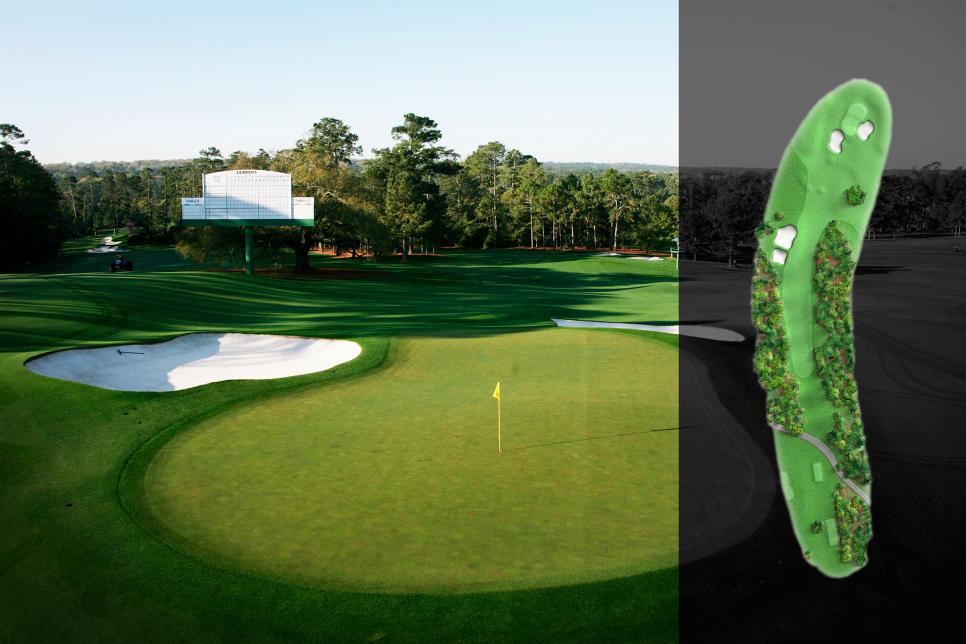
Augusta National’s 18th hole rises about 70 feet from the base of the fairway to the green. The elevation is one of the hole’s defenses as drives don’t roll much and uphill second shots are blind and must cover the front bunker. Uphill shots don’t bother professionals, but they can cause imprecision, and slight imprecisions at 18 are accentuated by the two-level green that might result in 75-foot putts and touchy recovery shots around the elevated putting surface.
The 18th can be a potential birdie hole or an easy bogey simply depending on where the hole is cut. When it's on the front lower section, approach shots can feed off the bank on the right, ride the spine separating the front and back tiers and curl close to the hole. When it’s on the elevated back level, approaches with longer clubs must fly all the way to the deck without bouncing over the green that falls away front, back, left and right.
The origins of Augusta National’s 18th hole
As designed, the 18th illustrated the elegance of the MacKenzie/Jones strategic principles. The hole rose up the incline and bent slightly right around a grove of mature pines. The best tactic was to play as aggressively toward the pines as possible to get a clear angle into the mouth of the green, the opening flanked by a bunker short left and another on the right. Risk a dangerous line, be rewarded with an advantageous angle. A bunker in the center of the fairway was only occasionally in play for the longest hitters, and only in severely dry years.
The green, which originally had a long lobe that extended into the fairway, was always two-tiered and sloped prodigiously from back to front, and in the early days players often elected to skip the ball onto the putting surface, especially if the pin was back. Being above the hole, even when greens were running the equivalent of four or five on the Stimpmeter, was never good (the Stimpmeter did not exist when the course was built).
The biggest changes to Augusta’s 18th hole
The first alterations to the 18th occurred at the green. Architect Perry Maxwell removed the long tongue in front during his course remodels in 1937 and ‘38. Robert Trent Jones later recalled watching the 1946 Masters with Bobby Jones when Ben Hogan came to the 18th needing just a par to tie Herman Keiser. Hogan played his approach to 12 feet but left it on the upper level when the flag was positioned beneath. There was no way Hogan could stop his ball near the hole, and he ended up three-putting to lose by one.
Trent Jones balanced the upper and lower sections so putts from above wouldn’t roll nearly off the green (the tiers would have to be modified repeatedly over the years as green speeds increased, especially following the 1981 Masters when the club converted to bentgrass). He also built up the surrounds so spectators could sit on the grassy banks and watch the players come up, some of golf’s first stadium seating.
The bunkers that now define the left side of the fairway were added prior to the 1967 Masters to prevent players—especially Jack Nicklaus—from bombing drives on that line to shorten the hole. This is another example of how the intended strategic concepts became watered down by distance and technology: 30 years into the tournament players no longer tried to hug the right side of the hole for an angle. They just wanted the shortest shot into the green as possible.
Watch our in-depth breakdown of the 11th hole
Continued efforts to make 18 more difficult
The club continued to make to make the drive on the 18th more difficult. In 1975, a grove of fully mature pine trees was transplanted to the left side of the hole about 200 yards from the tee, accentuating the “chute” factor of the tee shot and preventing players from intentionally hitting left of the fairway bunkers where a downslope would propel the ball forward (and left). This didn’t prevent Ian Woosnam from drawing his drive into the vast clearing left of the hole in the final round of the 1991 Masters, leaving him just a punch 9-iron to the green resulting in a par and a one-stroke victory.
In 2002, the club installed a cluster of small pines immediately left of the bunkers, cutting off the left option for good now that they’ve grown. That same year the tees were moved 60 yards back, lengthening the hole to 465 yards, the same distance it plays today. The extra distance was immediately shocking: in 2002 and 2003 the 18th played as the most difficult hole on the course.
Driving the ball through the corridor of pines is like threading a needle. Occasionally the trees will kill a tee shot launched slightly askew, as they did Jordan Spieth’s drive in 2018 when he was one shot behind eventual winner Patrick Reed. His ball clipped a limb and dropped straight down, leading to a bogey and a missed chance to shoot 63.
How the 18th hole plays today
The 18th remains a demanding finishing hole even though, unlike most others, the yardage has been static for two decades. Over the past four Masters it has played as either the second, third or fourth most-difficult hole in relation to par. But as distance gains off the tee continue to increase, players are once again starting to hit short irons into the green.
In some ways the 18th is quintessentially Augusta National. The club can regulate its challenge just by moving the hole around the green. Sunday back-hole locations can be brutal and make players grind out winning pars and even force mistakes, like in 1986 when Greg Norman, needing a 4 to tie Nicklaus, fanned his approach to the right and made bogey. Jose Maria Olazabal shared the lead in 1991 but hit his approach into the front bunker, leaving a treacherous shot up to the top tier. It didn’t quite climb the crest and rolled backward, leading to a five.
Conversely, Masters are often won with birdies when the hole is toward the front, especially the front-right location where both Mark O’Meara (1998) and Phil Mickelson (2004) poured in winning putts. Angel Cabrera and Adam Scott both birdied the hole in that spot in 2013, setting up their playoff.
If club officials wanted the 18th to be the most difficult hole on the course they could place the pin on the upper level all four days. But that’s the beauty of Augusta National and the way the course, specifically the greens, have evolved. It’s one of the most elastic designs in the game, where the par can effectively be set at 76 or 66, even for the world’s best players.

